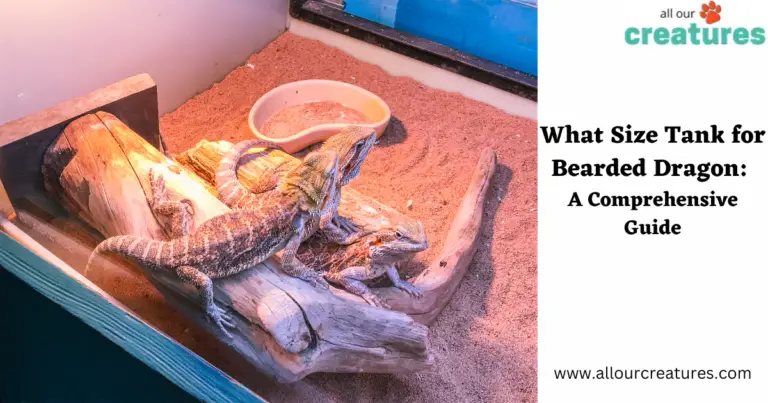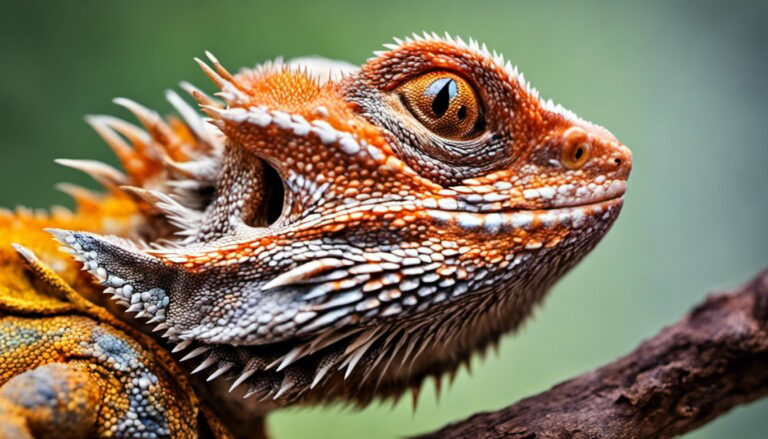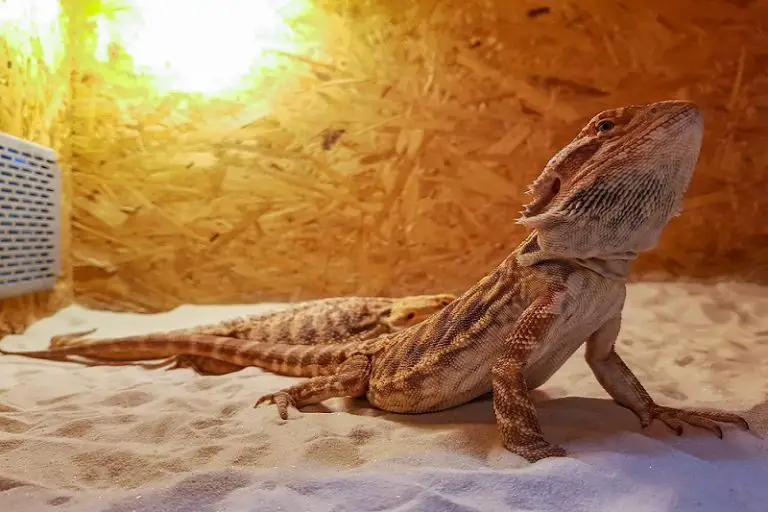How To Raise Bearded Dragons: Ultimate Guide To Caring For Your Beardie
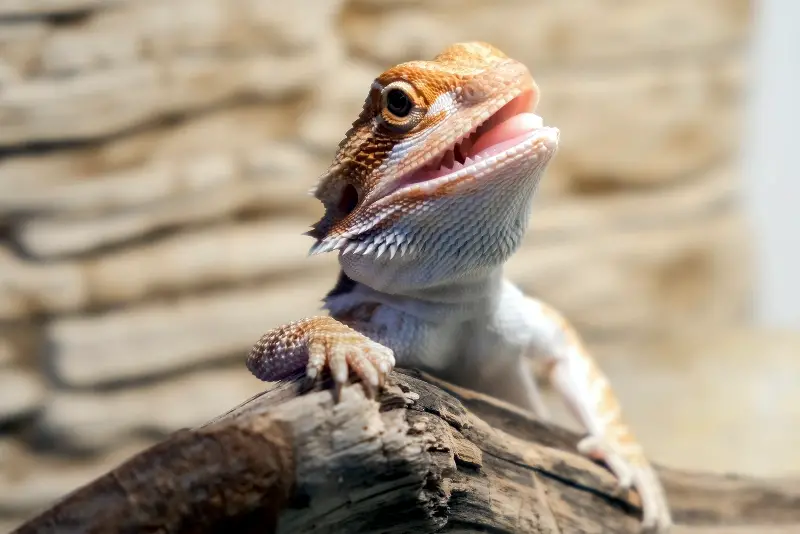
Bearded Dragons make a fantastic pet for anyone, no matter their age. They’re friendly, social, and fun to watch and play with. In this article, we’ll discuss what Bearded Dragons are, how to pick the right Beardie for you, and what equipment and diet they need from a baby to an adult. Overall, we’ll share everything about how to raise a Bearded Dragon.

Contents
Table of Contents
What Are Bearded Dragons?
Bearded Dragons are reptiles who are omnivores. Their nickname is the Beardie, and their scientific name is Pogona. These reptiles can grow to be between 16 and 24 inches long while weighing ten to 18 ounces. In addition, they can come in a few different colors, such as tan, red, or yellow. Also, they can morph into other colors, depending on their mood and body temperature.
It’s easy to tell a Bearded Dragon from other lizards because their bodies are covered in spiky reptilian scales. In fact, they have a spiky beard under their chin, thus giving them their name. Puffing out their spiky beard is part of how they communicate.
There are about eight species of Bearded Dragons that are recognized today.
They can have an average lifespan of about 4-10 years. However, some Beardies have lived for up to 15 years with proper care.
Overall, Bearded Dragons are gentle, social, and diurnal creatures. They enjoy being around their owners. Once you get the hang of setting up their habitat and learning what they need, Beardies are low-maintenance (and fun) pets to keep.
How To Pick The Best Bearded Dragon For You
Whether you’re looking to adopt a Bearded Dragon as a pet for yourself, for someone else as a gift, or for your child, there are some signs to watch out for when choosing a Beardie. For example, you’ll want to find a Bearded Dragon that’s healthy and alert. Unfortunately, not all Beardies at the pet store are in good condition.
You can certainly choose a sickly-looking Beardie and nurse it back to health. However, be mindful of the added medical costs and extra time they’ll need for care.
Overall, there are ways to choose a healthy Bearded Dragon from the pet store.
Choose An Alert Bearded Dragon
First, a healthy Beardie will most likely be alert and active inside their tank. Then, when people walk by, they’ll notice and be curious about them.
For instance, Bearded Dragons enjoy human interaction. Most enjoy people watching, so they might be by their window keeping watch.
Also, they’re most active during the day. So, if they’re slumped in a corner sleeping and not basking, then they might not be feeling well. Or, they might have just arrived at the store and aren’t ready to go to a new home yet.
Choose An Interactive Bearded Dragon
Once again, Beardies enjoy human interaction. So chances are, when you walk by, the Bearded Dragon will try to get your attention.
For example, they’ll walk back and forth, trying to make eye contact. They might stand tall and wave at you.
This is a good sign because it means they want to meet you and are looking for some human companionship.
Choose A Healthy Bearded Dragon
First, you’ll want to check the mouth. A healthy Beardie has a pink tongue and mouth. If it’s any other color, especially black, then they most likely have mouth rot.
Mouth rot is a sign of poor housing. For example, the habitat might not be adequately cleaned, or the temperature is too low.
This illness is curable, but the Bearded Dragon will need veterinarian care to heal their mouth rot.
If you can handle the added vet visits and bills and want to nurse the Beardie back to health, then you can certainly do so. Otherwise, it’s best to find a healthy reptile to bring home since it’ll create less stress for the both of you.
Otherwise, you can keep an eye out for other signs of illness, such as:
- Discolored Stomach
- Sunken Eyes
- Shriveled Skin
- Mangled (or bloody) Snout
- Jerky Behavior
- Bony Appearance
- Disfigured or Swollen Limbs or Tail
Talk To The Pet Store Staff
If you need help choosing a Beardie or you think you’ve found the right one, don’t be afraid to ask the staff questions.
For example, ask about the Bearded Dragon’s diet and how they typically behave day to day when the store is open. Some of the staff might have the answers for you, and some might not.
Overall, the pet store staff should know the basics of how to care for a Bearded Dragon.
Setting Up Your Bearded Dragon’s Tank
Before you bring home your Bearded Dragon, make sure you have all the equipment you need. In fact, you should already have their habitat set up and ready for its occupant. This way, you can ensure the temperature is already correct when you introduce your Beardie to their new home.
But first, let’s take a look at the supplies you’ll need:
- A glass terrarium with a screened top (at least 40 gallons in size)
- UVB Light (and UVA light)
- Heating lamp (or basking lamp)
- Basking platform (such as a log or rock)
- Thermometer
- Flooring
- Shallow food and water dishes
- Various decor (for climbing, hiding, and relaxing)
- Tweezers (to provide live feeder insects)
- Food (such as insects and vegetation)
Choose A Tank Size
Baby Bearded Dragons will need a tank size of at least 20 gallons. Juveniles need at least 40, and adults, depending on their size, should have an enclosure of at least 50 gallons to 125 gallons.
Remember, Bearded Dragons can grow to be over 20 inches long. So, the bigger the tank, the better.
Also, Beardies grow fast. So, if you adopt a baby, it’s best to buy a full-sized tank for when they’re an adult. Otherwise, you’ll be taking frequent trips to the pet store to upgrade the tank.
Choose A Location In Your Home
Before setting up the tank, make sure you place the habitat in a good spot in your home. The bigger the tank you have, the more space it’s going to take up.
So, you want the terrarium to be in a spot that’s not in the way in your home, but it also needs to be a good spot for your Bearded Dragon.
For example, your Beardie should not be in direct sunlight. The heat from the sun can quickly raise the temperature of the glass terrarium and become deadly for your Bearded Dragon.
Also, if you have young children or other pets around, be sure the tank is high enough that they won’t be able to get to your lizard. On the other hand, you want it to be a good spot where you can easily access the lighting and openings to feed your Beardie and interact with them.
Finally, make sure to put the habitat in a place that’s bright during the day and dark and quiet at night.
For example, if you have a home office and have the space, this might be a good area for them. You won’t be in the room at night, it should be quiet enough, and you and your Beardie will get to hang out while you work.
Choose A Safe Flooring
There are many flooring options for your Bearded Dragon. However, unlike choosing a carpet for your living room, not all flooring options are safe.
For example, substrate sounds like a good option because it looks like it mimics their real environment. However, most substrate can cause impaction if your Beardie accidentally digests it.
Also, some substrate might accidentally be inhaled, causing respiratory issues. Or, your Beardie might get it in their eye, causing other problems.
Finally, substrate is difficult for you to clean.
So, stay away from the following flooring options:
- Sand (or sand mats)
- Pebbles (or small rocks)
- Walnut Shells
- Wood Chips
- Coconut Fiber
- Calcium Powder
Instead, consider the following options.
Reptile Carpet
This particular carpet is soft and easy to clean. You can have more than one so that when you take it out to clean, you can immediately put the other one in so your Beardie is never without flooring.
There’s no way your Bearded Dragon can accidentally eat it, scratch their belly, or get it in their eye. So, this is one of the best options.
Tile
Tile is another good option. It’s easy to wipe clean, and the smooth surface will be easy for your lizard to walk upon.
Be sure to get a dark-colored tile so that it absorbs the heat from the lamps. Then your Beardie will have a semi-heated floor.
Tiles can scratch the bottom of the glass tank, so you can place thin towels on the bottom before putting the tiles on top to protect the glass.
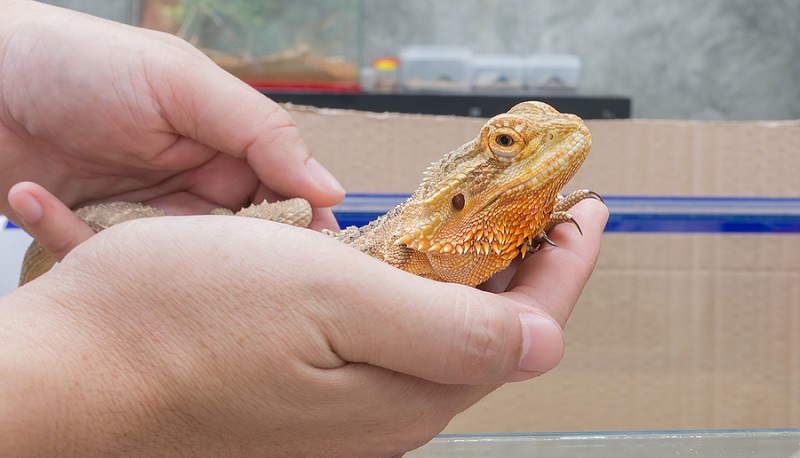
Clay
If you’re crafty with your hands, you can make the flooring with clay. Not only can you cover the bottom of the terrarium, but you can also create decor pieces such as caves and hills.
Cleaning might be difficult. For instance, you’ll need to take out the flooring and re-do it every month or so, depending on how messy your Beardie is. So, it could take a lot of time.
Also, if the clay gets wet and softens, pieces might break off, and your lizard might accidentally ingest it, getting impaction.
Choose Proper Lighting And Heat
Bearded Dragons are native to Australia. They’re used to warm temperatures. Also, they’re cold-blooded creatures, so they need heat and UVB rays to survive.
You’ll need to mimic this as best as possible within their habitat so that your reptile can thrive.
UVB Light
A UVB light creates heat and UVB rays. This particular light mimics the rays from the sun. Therefore, your Beardie can get vitamin D, allowing them to absorb calcium.
Bearded Dragons need a basking spot to help them digest after eating. So, they’ll head to the warmest spot where the UVB light is, creating a basking spot of about 95 to 100 degrees F.
Read our full guide to the best UVB light for bearded dragons here.
Heat Light
You also might need a heat light if the UVB bulb doesn’t give off enough heat for the rest of the tank. During the day, the tank should be between 75 and 85 degrees F, with the basking spot being between 95 and 100 degrees F.
Read our full guide to the best heat lamp to use for your Beardie here.
Ceramic Heat Emitter
At night, the tank should be cooler in temperature of about 65 to 74 degrees F. If your tank gets colder than that, you might need a ceramic heat emitter. This simply keeps the tank at a minimum of 65 degrees F.
You’ll also need a thermometer inside the tank. It’s a great idea to have a digital thermometer near the basking spot and in another tank spot. Then you can know how warm the habitat is while your Beardie is basking or while they’re relaxing in another spot of the tank.
Choose Decor
Finally, you’ll want to fill your Beardie’s terrarium with fun decor. This may include the following:
- Basking rock or log
- Hideaways (such as caves)
- Hammock
- Climbing structures (such as a bridge or logs)
Together, this decor allows your Bearded Dragon to wander and explore their environment. They can climb, relax, or play.
You can read more about fun things to do with your Beardie here.
How To Raise A Baby Bearded Dragon: Bearded Dragon Care For Beginners
Raising baby Bearded Dragons is different than raising Bearded Dragons when they’re older. For instance, they have a vastly different diet than adults. So, let’s talk about how to raise a baby Bearded Dragon.
Keep Your Baby Bearded Dragon Well Hydrated
Bearded Dragons are used to dry temperatures, but babies need to stay hydrated to grow correctly.
So, be sure to keep a shallow dish of fresh water in their tank. They can bathe in it, absorbing the water. In addition, you can mist them and the entire habitat three to four times per week.
Shedding Skin
Also, keeping your baby Bearded Dragon moist will help them shed their skin more easily. Babies shed their skin more often than adults.
Dietary Needs Of A Baby Bearded Dragon
How to care for baby Bearded Dragons also mean a different diet than adults. Remember, Bearded Dragons are omnivores, which means they eat live food and vegetation.
Baby Beardies need about 80% live food and 20% vegetables, such as dark leafy greens. For example, some veggies your baby Beardie can eat are:
- Dandelion greens
- Turnip greens
- Mustard greens
- Collard Greens
You can also feed them small amounts of certain fruits to add extra flavor to their meals.
Always chop up their food into tiny pieces, so it’s easy for your baby lizard to eat and swallow.
Insects To Feed Your Baby Bearded Dragon
The majority of their diet should be insects. In fact, they’ll need about two to three feedings of insects per day. Also, only feed them enough insects they can consume within ten to 15 minutes.
You can hand feed them insects with tweezers so you can be sure your baby is getting what they need. It’s also a great bonding moment between the two of you.
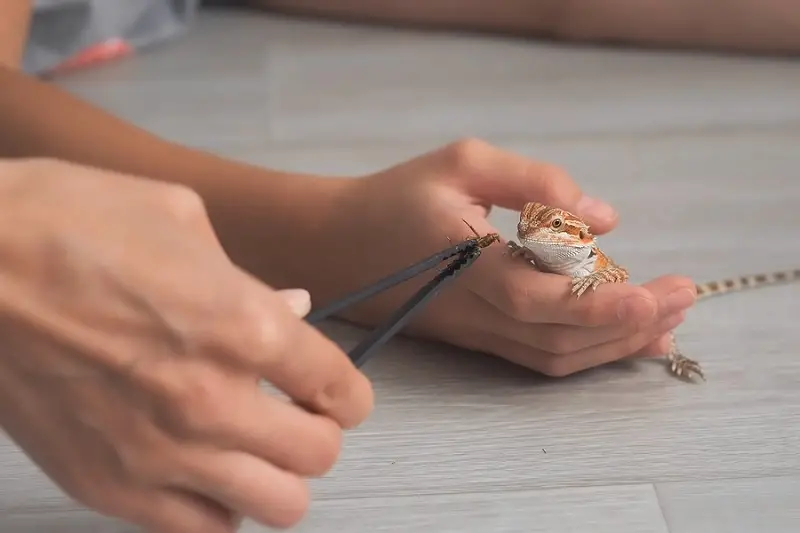
In addition, only feed insects that are small enough for your baby Beardie. Otherwise, it can be a choking hazard or cause impaction. Great options are small crickets and Dubia roaches.
Finally, to ensure your baby is getting the nutrients they need, you can gut-load the insects. This means feeding the bugs vegetation or other food to get certain nutrients, such as calcium. Then, when your baby eats the insect, they’ll get those nutrients.
Alternatively, you can dust the insects with supplements, such as calcium powder, to give your baby Beardie what they need.
Learn more about what baby Bearded Dragons can eat here.
How To Raise Bearded Dragons
Next, let’s discuss how to take care of Bearded Dragons as adults. Their diet is different than a baby Beardie or a juvenile Beardie.
For instance, as they grow older, they’ll need to eat less during the day. Not to mention that adults need a diet that’s richer in vegetation than live food.
For example, a Bearded Dragon is considered an adult once they’re 18 months old. Then, they’ll only need to be fed about once per day. In addition, their diet should consist of 70% vegetation, 25% protein from live food, and the other 5% can be treats from fruit.
Check out the table below to see what’s foods are appropriate to feed your adult Bearded Dragon.
| Vegetation | Live Food | Fruits (only small amounts) |
| Dandelion (greens and flowers) | Crickets | Tomatoes |
| Mustard greens | Mealworms | Bananas |
| Acorn squash | Waxworms | Apples |
| Collard greens | Phoenix worms | Grapes |
| Green beans | Dubia roaches | Apricots |
| Red or green lettuce | Discoia roaches | Papaya |
| Bell peppers | Silkworms | Cantaloupe |
| Carrots | Hornworms | Strawberries |
| Turnips (and turnip greens) | Superworms | Blueberries |
| Sweet potatoes | Turkestan roaches | Blackberries |
You can read more about what insects to feed your Beardie here or here for more information about fruits.
Lighting For Adult Bearded Dragons
Adult Bearded Dragons need UVB rays and proper heat to thrive. For example, their basking lamp should be on for about 12-14 hours per day.
After every feeding, your Beardie will bask for a little while to digest their food. The basking spot should be between 95 and 100 degrees F.
During the day, the rest of the tank should be between 75 and 85 degrees F. At night, the basking light should be turned off, and the tank’s temperature should be cooler, between 65 and 74 degrees F.
Play And Bond With Your Bearded Dragon
One of the best ways on how to look after Bearded Dragons is to bond with them. You can bond with your Beardie through holding, cuddling, bathing, or simply watching TV.
In addition, Bearded Dragons love to play. You can buy them various toys (cat toys work great) and even take them on walks.
Bonding and playing with your Beardie will allow them physical activity, mental stimulation, enrichment, and stave off boredom. Not to mention it’ll bring the two of you closer together.
Learn more about what Bearded Dragons can do for fun here or more of the best toys to give to your Beardie here.
Signs There Is A Problem With Your Bearded Dragon (And What To Do)
If your Bearded Dragon is feeling under the weather, they will certainly show signs. For example, they might be shaking, have discoloration of the mouth, be lethargic, have swollen eyes, and more.
Overall, they’ll show physical signs or have changes in their behavior.
Some common health issues for Bearded Dragons are as follows:
- Metabolic Bone Disease
- Parasites
- Infectious Stomatitis
- Respiratory Infections
- Atadenovirus (also known as Adenovirus)
If you notice any symptoms of your Bearded Dragon not acting like themselves or physically don’t look well, then be sure to call your veterinarian right away.
Some of these issues are treatable, but if not caught early enough, some of them can result in the death of your Bearded Dragon.
How To Care For A Bearded Dragon – Common Questions
Is It A Good Idea To Have More Than One Beardie?
You can have more than one Bearded Dragon. However, it’s not recommended. Beardies enjoy the company of their humans rather than other Bearded Dragons. For instance, some can get territorial.
However, if you have two kids who each want a Beardie of their own, then you can have more than one as long as they’re not housed together.
There are a few reasons for this. Two males housed together can be territorial, with one potentially killing the other. Two females together will cause one to dominate the other, thus taking over the food bowl and basking spot. The other female will get seriously ill.
Finally, if you house a male and a female together, you might end up with more than two Bearded Dragons in the long run.
Overall, if you have more than one Bearded Dragon, keep them in separate habitats and separate rooms. Also, try to get two females, if possible. They have the best chance of getting along if they meet outside their tanks.
What’s The Best Way To Clean My Tank?
Cleaning your Beardie’s tank is easier than it seems. They have a lot of decor, so that it may look intimidating. However, if you spot-clean often, then you can keep the habitat relatively clean.
For instance, give your Bearded Dragon’s tank a good look-over every night before turning off their basking light.
Remove any uneaten food and feces from the day with a small shovel. Or, you can pick it up with your hand using a paper towel.
Depending on the flooring you have, you can switch out and clean the carpet once a week. Tile can be spot-cleaned every day.
At least once a month, you’ll want to give the tank a good, deep clean. First, make sure your reptile is in a safe area and away from the tank. Then, take out all the decor and rinse them in warm water to get off any stains.
You can take out the flooring and give that a good rinse as well. Also, if the sides of the tank (inside and outside) are visibly dirty, you can spot clean them.
Before putting your Beardie back into their tank, make sure it’s dry and well-aired out from your cleaning.
How Easy Are Bearded Dragons To Take Care Of?
Bearded Dragons are relatively easy to care for. However, once you have their terrarium set up with the proper flooring, decor, and lighting, then you’ll want to maintain their diet.
Most Beardies aren’t too picky when it comes to feeding, but you’ll need to do some trial and error to see which foods are your Bearded Dragon’s favorites.
Otherwise, be sure to give them a lot of attention and playtime. Setting aside an hour a day to hang out with them will be ideal for both of you.
Conclusion
That’s how to care for Bearded Dragons in a nutshell. They need a lot of equipment and have special dietary needs from a young age.
However, they’re friendly pets and are easy to care for once you get the hang of it. Overall, Bearded Dragons are fairly sturdy and will enjoy your company.
Click here to read more about what to feed your Bearded Dragon, more about the best toys for them here, the best UVB light for bearded dragons here, here to learn about brumation and here to learn how your Beardie shows affections. You can also read how to breed Bearded Dragons here. Learn more about Bearded Dragons here.


![Best Bedding For Bearded Dragons [Full Guide + Top Options]](https://allourcreatures.com/wp-content/uploads/2021/12/bigstock-Bearded-Agama-latin-Pogona-V-396699188-768x498.jpg)

